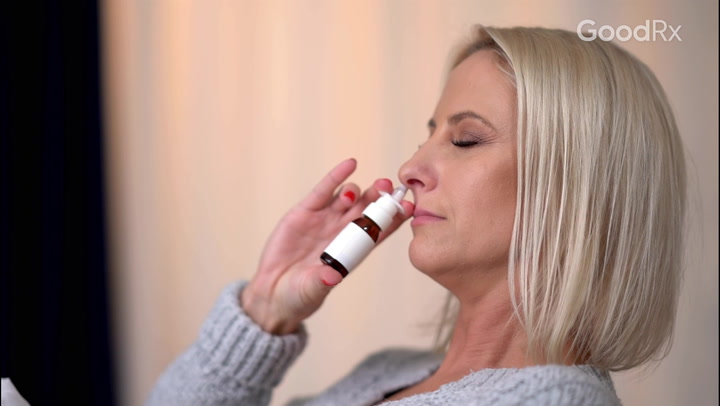
Benadryl, Zyrtec, and More: A List of 7 Antihistamines
Key takeaways:
Antihistamines are a class of medications most often taken to treat allergy symptoms. There are first-, second-, and third-generation antihistamines.
First-generation antihistamines can often treat other symptoms besides allergies. But they tend to cause more side effects, such as drowsiness. Examples include hydroxyzine (Vistaril) and Benadryl (diphenhydramine).
Second- and third-generation antihistamines are often preferred for treating seasonal allergies and hives. They typically cause less drowsiness. Common examples include Zyrtec (cetirizine), Claritin (loratadine), and Allegra (fexofenadine).
There are many ways to save on antihistamines. Many are available as lower-cost generics. GoodRx can help make your medication more affordable.
Table of contents

Seasonal allergies affect about 1 in 4 U.S. adults each year. Antihistamines are popular allergy medications, and many are available over the counter (OTC).
But not all antihistamines are created equal. And some can treat more than just allergy symptoms.
What are antihistamines, and how do they work?
Antihistamines are a popular and versatile class of medications. They primarily work by blocking a chemical your body makes called histamine.
With allergies, your body thinks a harmless substance, such as pollen or pet dander, is harmful and releases histamine. Histamine then causes allergy symptoms such as runny nose, sneezing, and watery eyes. By blocking histamine, antihistamines help relieve these symptoms.
Antihistamines are separated into three main groups called generations:
First-generation antihistamines: Older antihistamines that can pass into the brain more easily, making them more likely to cause drowsiness.
Second-generation antihistamines: Newer antihistamines that are less likely to cause drowsiness.
Third-generation antihistamines: Newer antihistamines that are created from second-generation antihistamines and are also less likely to cause drowsiness.
Search and compare options
Experts recommend second- and third-generation antihistamines for seasonal and other skin allergies because they cause less drowsiness. This is especially true for adults ages 65 and older. Older adults should avoid first-generation antihistamines in most cases. These antihistamines can raise the risk of falls in this age group, which can be serious.
Below, you’ll find a list of seven common antihistamines, plus some key differences that set them apart.
1. Hydroxyzine
Hydroxyzine (Vistaril) is a first-generation antihistamine that’s only available with a prescription. It’s FDA approved for:
Seasonal and year-round allergies
Itching due to allergic skin conditions, such as chronic hives
Sedation before surgery
It comes in two different forms that are similarly effective: hydroxyzine pamoate and hydroxyzine hydrochloride. Their biggest difference is their dosage forms. Hydroxyzine pamoate is only available as capsules. Hydroxyzine hydrochloride is available as an oral tablet, oral liquid, and injectable liquid (used in hospital settings).
Hydroxyzine starts working in 15 to 30 minutes, but it may start wearing off about 4 hours later. Many people need to take it 3 to 4 times a day. Hydroxyzine also hasn’t been well studied for long-term use. So it’s possible your prescriber may suggest taking hydroxyzine only as needed or for short periods of time.
Hydroxyzine is the only antihistamine that’s approved for anxiety. Experts believe it likely boosts serotonin levels in the brain. Serotonin is a chemical that plays a role in mood and anxiety. Hydroxyzine is the only antihistamine known to affect serotonin. But because there are more effective treatments available, it’s not a first-choice option for anxiety.
Read more like this
Explore these related articles, suggested for readers like you.
Hydroxyzine commonly causes drowsiness, which is why it’s sometimes prescribed off-label for sleep. If possible, avoid taking hydroxyzine with other medications that also cause drowsiness, such as opioids and muscle relaxers. You should also avoid taking it with other antihistamines unless your prescriber tells you to do so.
2. Benadryl
Benadryl (diphenhydramine) is another first-generation antihistamine. It’s used for the temporary relief of watery eyes, runny nose, and sneezing caused by allergies or the common cold. Diphenhydramine (Benadryl’s active ingredient) is also commonly included in OTC sleep aids and cold medications.
Benadryl comes in several dosage forms, most of which are available OTC:
Oral tablets
Oral capsules
Chewable tablets
Oral liquid
Injection (prescription only, used in hospital settings)
Similar to hydroxyzine, oral Benadryl starts working in about 15 to 30 minutes. Most people can take it every 4 to 6 hours as needed for allergy or common cold symptoms.
Drowsiness is a common side effect of Benadryl. That’s why it’s often found in OTC sleep aids. Taking Benadryl or products that contain diphenhydramine to help with occasional sleep troubles is safe for most adults and adolescents over 12 years old. But you shouldn’t take Benadryl for sleep for longer than 2 weeks without a healthcare professional’s OK.
Good to know: Healthcare professionals will sometimes recommend taking Benadryl for mild allergic reactions, such as a mild rash or hives. But you should only do this with a healthcare professional’s OK. Depending on your symptoms, they may want to evaluate you in person or have you seek more urgent medical care.
3. Zyrtec
Zyrtec (cetirizine) is a second-generation antihistamine that can help relieve allergy symptoms. It’s available OTC and is a common choice for everyday use.
Zyrtec comes in a few dosage forms:
Oral tablets
Oral capsules
Chewable tablets
Orally disintegrating tablets (ODTs)
Oral liquid
Zyrtec starts working within about 20 to 60 minutes. And one dose can last for up to 24 hours.
Even though Zyrtec is a second-generation antihistamine, drowsiness is still a common side effect. But it’s less likely to happen compared to first-generation antihistamines. Taking Zyrtec at night can help limit daytime sleepiness.
4. Claritin
Another well-known second-generation antihistamine is Claritin (loratadine). It’s available OTC and comes in many different formulations:
Oral tablets
Oral capsules
Chewable tablets
ODTs
Oral liquid
Claritin takes a little longer to start working — about 1 to 3 hours. But most of the adult dosage forms are designed to last for up to 24 hours. And it’s safe for most people to take it every day for allergy prevention.
Claritin rarely causes drowsiness when taken as recommended. But some studies suggest it may be less effective for seasonal allergies than other antihistamines.
5. Allegra
Allegra (fexofenadine) is a third-generation antihistamine. It’s available OTC in a few dosage forms:
Oral tablets
Oral capsules
Oral liquid
ODTs
Allegra usually starts working within 1 to 2 hours. And the adult formulations should keep working for up to 24 hours. Allegra is safe for most people to take every day. It’s the least likely of all antihistamines to make you drowsy.
Notably, there’s an Allegra product labeled for itch relief due to hives. It contains the same active ingredient (fexofenadine) as products labeled for allergy relief. Other OTC antihistamines don’t list itch relief from hives on their labels. However, all second- and third-generation antihistamines are effective treatments for hives.
6. Xyzal
Xyzal (levocetirizine) is another third-generation antihistamine that’s available both OTC and with a prescription. The OTC version is labeled for allergy relief. The prescription version is FDA approved to treat chronic hives. Xyzal comes as an oral tablet and oral liquid.
Xyzal typically starts working within 1 hour. And it should keep working for about 24 hours. It’s considered safe to take long term if needed. It can cause drowsiness for some people. But it’s less likely to make you sleepy compared to Zyrtec and first-generation antihistamines.
Good to know: Xyzal’s OTC label doesn’t include dosage information for adults ages 65 and older. This is because older adults may be more sensitive to the drowsiness it can cause. If you’re 65 or older, speak to your healthcare team before taking Xyzal.
7. Promethazine
Promethazine (Promethegan) is a prescription-only, first-generation antihistamine. It’s FDA approved for a variety of conditions, including:
Relief of seasonal and year-round allergy symptoms
Runny or stuffy nose that’s not caused by allergies or an infection
Treatment and prevention of motion sickness
Mild allergic skin reactions
Sedation before surgery
Promethazine blocks both histamine and dopamine in the brain. Medications that block dopamine can sometimes be helpful for nausea and vomiting.
Promethazine comes as an oral tablet, oral liquid, and rectal suppository. There’s also an injectable version that can be administered in hospital settings. And promethazine is included in several combination prescription cough syrups, such as promethazine / codeine.
Promethazine can start working pretty quickly — within 20 minutes. But depending on why you’re taking it, you may need to repeat doses every 4 to 6 hours for continued effects.
Promethazine commonly causes drowsiness. And it’s one of the few antihistamines that can cause serious side effects in children when taken as recommended. Promethazine can cause life-threatening breathing troubles in young children, especially those under 2 years old. But there are reports of this happening in children up to 16 years old.
How to save on antihistamines
There are ways to save on antihistamines. GoodRx can help you navigate your options, including GoodRx discounts. You can even apply GoodRx coupons to OTC antihistamines if your health professional writes you a prescription for them. You can find antihistamine prices as low as about $4 per month with a free GoodRx discount.
The bottom line
Antihistamines are often taken to relieve symptoms of allergies. First-generation antihistamines, such as hydroxyzine (Vistaril) and Benadryl (diphenhydramine), are more likely to cause drowsiness. Second- and third-generation antihistamines, such as Claritin (loratadine) and Allegra (fexofenadine), are less likely to make you sleepy.
Many antihistamines are available over the counter. Speak with your prescriber or pharmacist to see which one might be right for you.
Why trust our experts?



References
American Academy of Allergy, Asthma, and Immunology. (2020). Choices of second-generation antihistamines in chronic spontaneous urticaria.
Amneal Pharmaceuticals LLC. (2022). Promethazine hydrochloride [package insert].
Bryant Ranch Prepack. (2023). Levocetirizine dihydrochloride [package insert].
Bryant Ranch Prepack. (2024). Promethazine hydrochloride [package insert].
Centers for Disease Control and Prevention. (2023). More than a quarter of U.S. adults and children have at least one allergy.
Chartwell RX, LLC. (2023). Hydroxyzine hydrochloride [package insert].
Chattem, Inc. (2024). Allegra Hives 24hr [package insert]. DailyMed.
Chattem, Inc.. (2024). Xyzal Allergy 24hr [package insert]. DailyMed.
Farzam, K., et al. (2023). Antihistamines. StatPearls.
Fein, M. N., et al. (2019). CSACI position statement: Newer generation H1-antihistamines are safer than first-generation H1-antihistamines and should be the first-line antihistamines for the treatment of allergic rhinitis and urticaria. Allergy, Asthma & Clinical Immunology.
Gautam, S., et al. (2017). Clinical practice guidelines for the management of generalised anxiety disorder (GAD) and panic disorder (PD). Indian Journal of Psychiatry.
Henry Schein, Inc. (2023). Hydroxyzine [package insert].
HF Acquisition Co. LLC. (2024). Diphenhydramine hydrochloride [package insert].
HF Acquisition Co. LLC. (2024). Promethazine HCI [package insert].
Hong, D., et al. (2023). Efficacy of different oral H1 antihistamine treatments on allergic rhinitis: A systematic review and network meta-analysis of randomized controlled trials. Brazilian Journal of Otorhinolaryngology.
Huang, C., et al. (2019). Antihistamine effects and safety of fexofenadine: A systematic review and Meta-analysis of randomized controlled trials. BMC Pharmacology and Toxicology.
Johnson & Johnson Consumer Inc. (2024). Benadryl Allergy Extra Strength [package insert]. DailyMed.
MedlinePlus. (2019). Histamine: The stuff allergies are made of [video].
PharmPak, Inc. (2022). Promethazine [package insert].
RedPharm Drug Inc. (2021). Hydroxyzine pamoate [package insert].
RemedyRepack Inc. (2024). Hydroxyzine hydrochloride [package insert].
Southard, B. T., et al. (2024). Promethazine [package insert]. StatPearls.
Starke, P. R., et al. (2005). Boxed warning added to promethazine labeling for pediatric use. The New England Journal of Medicine.





























